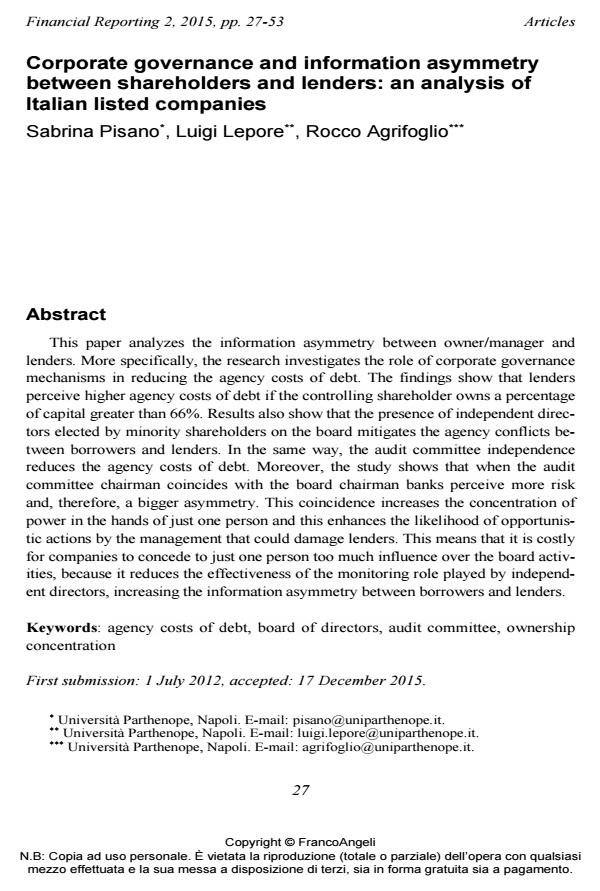Corporate governance and information asymmetry between shareholders and lenders: an analysis of Italian listed companies
Titolo Rivista FINANCIAL REPORTING
Autori/Curatori Sabrina Pisano, Luigi Lepore, Rocco Agrifoglio
Anno di pubblicazione 2016 Fascicolo 2015/2
Lingua Inglese Numero pagine 27 P. 27-53 Dimensione file 295 KB
DOI 10.3280/FR2015-002002
Il DOI è il codice a barre della proprietà intellettuale: per saperne di più
clicca qui
Qui sotto puoi vedere in anteprima la prima pagina di questo articolo.
Se questo articolo ti interessa, lo puoi acquistare (e scaricare in formato pdf) seguendo le facili indicazioni per acquistare il download credit. Acquista Download Credits per scaricare questo Articolo in formato PDF

FrancoAngeli è membro della Publishers International Linking Association, Inc (PILA)associazione indipendente e non profit per facilitare (attraverso i servizi tecnologici implementati da CrossRef.org) l’accesso degli studiosi ai contenuti digitali nelle pubblicazioni professionali e scientifiche
This paper analyzes the information asymmetry between owner/manager and lenders. More specifically, the research investigates the role of corporate governance mechanisms in reducing the agency costs of debt. The findings show that lenders perceive higher agency costs of debt if the controlling shareholder owns a percentage of capital greater than 66%. Results also show that the presence of independent directors elected by minority shareholders on the board mitigates the agency conflicts between borrowers and lenders. In the same way, the audit committee independence reduces the agency costs of debt. Moreover, the study shows that when the audit committee chairman coincides with the board chairman banks perceive more risk and, therefore, a bigger asymmetry. This coincidence increases the concentration of power in the hands of just one person and this enhances the likelihood of opportunistic actions by the management that could damage lenders. This means that it is costly for companies to concede to just one person too much influence over the board activities, because it reduces the effectiveness of the monitoring role played by independent directors, increasing the information asymmetry between borrowers and lenders.
Parole chiave:Agency costs of debt, board of directors, audit committee, ownership concentration
- Can a corporate social responsibility committee be utilized to enhance the effectiveness of independent directors? Sabrina Pisano, Gabriella D’Amore, Loris Landriani, Luigi Lepore, in Corporate Ownership and Control /2022 pp.201
DOI: 10.22495/cocv20i1art18 - The role of board composition in CSR disclosure: An empirical analysis in four European countries Carmela Di Guida, Alfredo Celentano, Francesco Mirone, Gabriella D’Amore, in Corporate Governance and Organizational Behavior Review /2022 pp.74
DOI: 10.22495/cgobrv6i3p7 - Corporate governance in the digital age: the role of social media and board independence in CSR disclosure. Evidence from Italian listed companies Luigi Lepore, Loris Landriani, Sabrina Pisano, Gabriella D’Amore, Stefano Pozzoli, in Journal of Management and Governance /2023 pp.749
DOI: 10.1007/s10997-021-09617-2
Sabrina Pisano, Luigi Lepore, Rocco Agrifoglio, Corporate governance and information asymmetry between shareholders and lenders: an analysis of Italian listed companies in "FINANCIAL REPORTING" 2/2015, pp 27-53, DOI: 10.3280/FR2015-002002